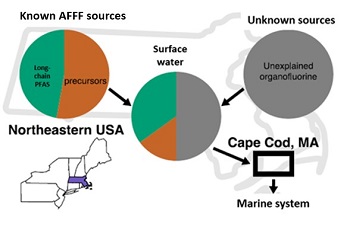Hot Off the Press
Research Briefs
Combined Approach Sheds Light on Factors Controlling Stream Recovery
Improved water quality and stream ecosystem recovery following treatment of mine waste depends on a mix of physical, chemical, and biological factors, according to a new study funded by the SRP at the Colorado School of Mines. William Clements, Ph.D., professor at Colorado State University, and two doctoral students, led the study.
New Technique Sheds Light on PFAS in Coastal Watersheds

A new analytical workflow, developed by SRP researchers, can identify and characterize previously undetected PFAS compounds incontaminated watersheds. The team is led by Elsie Sunderland, Ph.D., of the University of Rhode Island SRP Center, and SRP trainee Bridger Ruyle, a doctoral student at Harvard University.
Arsenic Exposure Before Conception may Trigger Diabetes in Male Offspring
Exposure to inorganic arsenic before conception can alter metabolic outcomes in the offspring of mice, with different effects among males and females, according to a new study by the University of North Carolina at Chapel Hill SRP Center. Researchers reported, for the first time, a link between changes in gene expression in parents' reproductive cells and diabetic indicators in offspring.
Environmental Factor Articles
Data Sharing Key to Environmental Health Research, Experts Say

Three NIEHS Superfund Research Program events focus on how data science can be harnessed to better study contaminants. By combining data across different projects and disciplines, SRP-funded scientists will help to answer complex, never-before-answered questions, according to SRP Director William Suk, Ph.D.
Hazardous Waste Cleanup Focus of Federal Roundtable
Scientists from NIEHS and other federal agencies discussed emerging challenges and promising technologies. Leaders from NIEHS and ten other federal agencies discussed innovative strategies to tackle emerging challenges related to hazardous waste cleanup as part of Federal Remediation Technologies Roundtable (FRTR) webinars, held May 19 and May 26.
Paper of the Month: New Approach Sheds Light on PFAS in Coastal Watersheds
NIEHS-funded researchers developed a new tool to identify and characterize previously undetected PFAS in watersheds on Cape Cod, Massachusetts. The team identified a distinct signature for PFAS from aqueous film forming foam, which is used in firefighting and can contaminate drinking water. However, a large fraction of fluorine could not be explained.
Paper of the Month: New Marker of COVID-19 Severity Points to Potential Therapies
Certain fatty acids in the blood of COVID-19 patients may predict the severity of adult respiratory distress syndrome (ARDS) and offer a target for treatment, according to a new NIEHS-funded study. ARDS involves a buildup of fluid in the lungs and is a leading cause of death in COVID-19 patients.
Paper of the Month: Researchers Pinpoint Molecular Trigger for Lung Fibrosis
A new NIEHS-funded study revealed a series of molecular steps that lead to severe scarring in the lungs, called idiopathic pulmonary fibrosis, in response to environmental exposures. The key step involves a modified version of vimentin, a structural protein that usually maintains cellular integrity.
Paper of the Month: DNA Repair Enzyme Controls Switch from Cancer to Tissue Damage
NIEHS-funded researchers discovered a DNA-repair molecule that affects susceptibility to disease in mice exposed to N-nitrosodimethylamine. Alkyladenine DNA glycosylase is known to be an important player in DNA repair, but this study revealed for the first time that too much or too little can control the switch between cancer and lethality.
Biomarker Suggests Severity of COVID-19 Respiratory Distress
In a study funded in part by NIEHS , researchers at the UCD SRP Center reported April 1 that certain fatty acids in the blood of COVID-19 patients may predict the severity of adult respiratory distress syndrome (ARDS). The fatty acids may also offer a target for treatment. ARDS, characterized by fluid buildup in the lungs, is the second leading cause of death in COVID-19 patients, according to the National Center for Biotechnology Information.
Environmentally Persistent Free Radicals may Affect Lung Health
Environmentally persistent free radicals may reduce people's ability to fight respiratory infections, according to Stephania Cormier, Ph.D. Cormier, director of the LSU SRP Center spoke to NIEHS on March 31, as part of the Keystone Science Lecture Seminar series.
Water Contaminant NDMA Linked to Cancer Cluster in Massachusetts

Prenatal exposure to N-nitrosodimethylamine (NDMA) is linked to childhood cancer, according to a long-term study released March 24 by the Massachusetts Department of Public Health (DPH). SRP grantees at MIT published a study in the journal Cell Reports that revealed molecular details about how NDMA causes disease in mice.
Paper of the Month: Hospitalization Following Extreme Weather, Opportunities for Resilience
NIEHS-funded researchers observed an increase in respiratory disease and other hospitalizations among older adults following exposure to tropical cyclones, which may help hospitals become better prepared in the future. Tropical cyclone is a generic term used to describe tropical depressions, tropical storms, and hurricanes.
Data Science Paves the Way with New Tools, Insights for SRP
An SRP data showcase featured approaches to make data more findable, accessible, interoperable, and reusable. SRP held its first External Use Case Showcase Feb. 18-19. Over 140 participants joined the meeting to share experiences and recommendations about integrating datasets from SRP-sponsored research. EUCs, developed by collaborations of researchers from different SRP centers, demonstrate specific scenarios in which data management and sharing could provide new insight on research questions and to identify barriers to inform future data efforts.
Paper of the Month: New Study Sheds Light on TCE Bioremediation
Researchers at the UC Berkeley SRP Center demonstrated that natural microbial communities amended with acetylene can break down chlorinated contaminants, and in the process, they discovered a new bacteria species.
Microbiome Workshop Dives Deep into Expanding Field

More than 500 researchers - from senior scientists to undergraduate students - participated in a virtual NIEHS workshop exploring the latest research on the microbiome and environmental health. NIEHS played virtual host to a wide-ranging look at the latest research on the microbiome and environmental health during a Feb. 23-24 workshop.
SRP Risk e-Learning Series
SRP hosted a Risk e-Learning webinar series focused on SRP-funded data science projects that are enhancing the integration, interoperability, and reuse of data. The series featured research by SRP grantees and colleagues collaborating to integrate existing data to generate new findings and answer questions that could not be answered before. Outside speakers from the EPA, National Science Foundation (NSF), and the Global Alliance for Genomics and Health, with complementary expertise in data sharing tools and initiatives also presented.
The first session introduced tools, strategies, workflows, and platforms developed by SRP researchers to organize existing data obtained from measuring contaminants in an array of environmental media to facilitate interoperability. It also featured the EPA's CompTox Chemicals Dashboard, a compilation of information from many websites and databases developed to organize chemical data and address data gaps.
In the second session ,presenters described efforts to combine and analyze datasets from SRP Centers and other sources using geospatial platforms. This session also featured a speaker supported by NSF who discussed Hydroshare, an online system to share hydrologic data and models.
The third and final session will be held August 3 from 2 - 4 p.m. EDT. It will feature SRP-funded researchers collaborating to combine omics data, such as genomics, proteomics, within and across model organisms as well as studies in human populations. It also included speakers from The Global Alliance for Genomics and Health.
to Top



